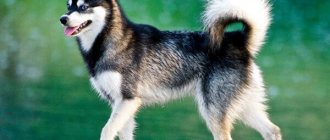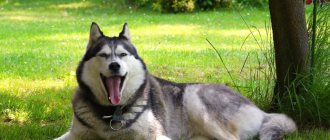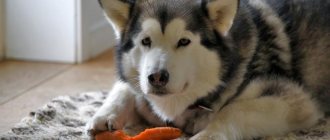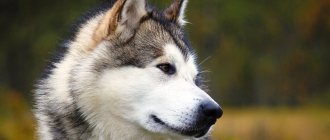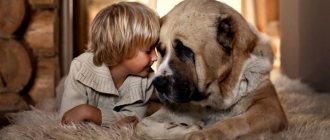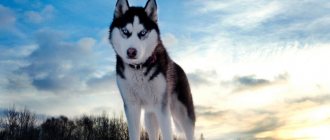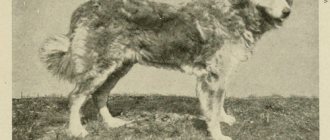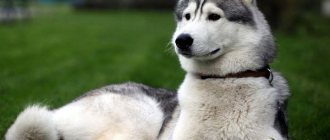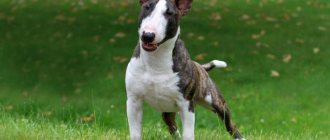Short description
These are powerful dogs with a strong and muscular body. Adult males reach 63.5 cm at the withers and weigh 38 kg, females grow up to 58.5 cm and weigh 35 kg.
For dogs that meet the breed standard:
- wide but proportional head;
- voluminous muzzle;
- erect, wide-set, V-shaped ears with rounded tips;
- scissor bite;
- small almond-shaped eyes, brown iris;
- the nose is colored black or brown;
- powerful limbs with developed muscles.
Alaskan Malamutes have a two-layer coat, consisting of a dense fluffy undercoat about 2.5-5 cm long and thick and coarse guard hairs maximum 7.5-10 cm long..
Long-haired dogs whose coat length exceeds these indicators are considered plembrac.
Origin story
Alaskan Malamutes are a breed of dog originally from Alaska, descended from domesticated dogs of the Malamute tribe, which were characterized by strength, power and a high degree of endurance.
The Malemuts used these animals for riding and transporting goods.
The peak of development and spread of the breed occurred at the end of the 19th century, during the so-called “gold rush” . This happened because gold miners could only reach the deposits by sledding Alaskan Malamutes.
In order to increase the number and increase the endurance of dogs, they were crossed with representatives of other breeds, which is why the number of purebred individuals significantly decreased.
The revival of the breed began only after sled racing gained popularity, and the risk of extinction of Alaskan Malamutes was completely avoided only in the 20s. XX century
The breed received official recognition in 1935.
History and important characteristics of the breed
Malamute is a breed of proud and strong dogs
The Alaskan Malamute is native to North America. This is one of the most ancient breeds. Based on genetic studies conducted in 2004, scientists came to the conclusion that Malamutes originated from domesticated wolves that lived in Central and East Asia, which later came to North America with nomads. This happened during the Pleistocene era approximately 14 thousand years ago.
The breed got its name from the Mahlemut tribe, which used dogs for hunting and transporting goods.
The breed gained popularity among Europeans in 1896 during the gold rush. Seekers of the precious metal had to navigate the harsh northern climate, which led to the demand for the rock and an increase in its value. The Alaskan Malamute became the most expensive dog, its price reaching up to $40,000 by modern standards.
In 1908, a sled dog race was held. Malamutes also took part in it, but they failed to win. Despite their adaptability to severe frosts and endurance, they were inferior in speed to other breeds. In an effort to improve the characteristics of the animals, owners began to cross them with other, smaller dogs. As a result, the number of purebred Alaskan Malamutes decreased so much that by 1920 they were on the verge of extinction.
The dogs were saved from extinction by several breeders who united in a group and restored the breed. Over the next 20 years, three lines of Malamutes were formed:
- Hinman-Irwin;
- M'Luth;
- Kotzebue.
Modern dogs evolved from them. During World War II, the breed was again in danger of extinction. Malamutes rescued wounded soldiers, and many dogs died in the process. In 1947, only 30 individuals were recorded. This time the breed was restored, but the purity of the line was violated. Today, Alaskan Malamutes are popular all over the world.
Important! Despite their powerful build, the dogs are suitable for living in an apartment.
Character traits
Alaskan Malamutes, due to their large size, may appear to be intimidating dogs, but in fact they are very sociable and good-natured.
These dogs cannot be guards because they are not aggressive at all and are friendly towards everyone without exception..
Being pack animals, Malamutes need constant communication with people and other animals; living in isolation negatively affects their health.
They also need regular active walks, physical activity and a variety of activities, since the monotonous repetition of the same actions quickly causes them boredom.
Despite the attachment to the owner, it is important for Malamutes to constantly confirm his leadership and authority - as soon as a person shows weakness, the pet begins to look for a leader in someone else.
It is also important to remember that representatives of this breed are stubborn, willful and prone to dominant behavior, so it can be difficult to train them.
If you don’t have confidence in your own abilities, it is better to turn to professional dog handlers and undergo OKD.
Expert opinion
Kozhevin Semyon Kirillovich
Expert dog handler.
Representatives of this breed are definitely not suitable as a first pet for novice dog owners. Only an experienced person with leadership qualities and a strong character can cope with the stubbornness, willfulness and desire to dominate the Alaskan Malamute. Malamutes are not aggressive by nature, but this behavior can be provoked by psychological trauma suffered at an early age, errors in upbringing, cruel treatment and some other reasons.
Character of the breed
Yes, they tried to make the dog an ideal hunter and watchman. But, the truth is, it didn’t really work out. The dog may look like a wolf, but he is not a good defender.
Despite their good nature and sociability, with improper upbringing or lack of training, the Alaskan Malamute (as well as a husky or a husky) turns into a dangerous and uncontrollable dog that seeks to dominate everyone. It is very important to raise a dog from Alaska and constantly prove to him that the main person in the house is not the animal! Otherwise there will be a lot of problems.
In addition, Malamutes cannot bark, but they sing well. Many have heard huskies, huskies, and malamutes sing. There are plenty of videos online. But you can’t warn the owners with a song that a stranger is “in charge” of the apartment.
This breed has an excellent memory! After all, they had to somehow return home through the snow. And, despite the fact that in our climate there is no need to look for a road in the snow, an excellent memory has been preserved. Therefore, you need to be careful both when training and simply when handling the dog. The malamute will not only remember bad treatment, but will also remember you and take revenge.
Training a handsome Alaskan is not so easy. Yes, the dog is smart, but he quickly gets bored with the monotony and starts to get bored. Therefore, structure your training so that both the animal has fun and the training is useful. Praise more, give treats, but don’t be rude or punish. Affection gives much more positive results with these stubborn people than scolding.
Due to the fact that the “gray everyday life” and constant routine bore the Malamute, he quickly finds entertainment by demolishing everything in the apartment. When you come home from work, you will probably find broken pots, chewed furniture, torn wallpaper, torn pillows and other mess. Huskies and Malamutes do not like confined spaces; they are much more comfortable in the wild, in a huge enclosure (with mandatory walking in an open space).
If there are children or small animals at home, then they should not be left alone with the Alaskan dog. He is large and wants to be dominant. Therefore, he can easily injure someone who is weaker than him. Many have seen how huskies and malamutes “pretend” to be a cat: they lie with their paws crossed, or they also hunt, hiding, and then jumping up sharply.
Advantages and disadvantages
Speaking about the advantages of representatives of this breed, it should be noted that they not only have an attractive appearance , but also :
- good-natured;
- friendly;
- hardy;
- smart;
- love children;
- not aggressive at all;
- sociable.
In addition, their coat does not have the unpleasant specific smell of a dog.
But Alaskan Malamutes also have disadvantages.
Yes, these dogs:
- prone to dominant behavior;
- stubborn;
- do not have protective instincts;
- independent;
- love to dig holes;
- howl often.
It should also be remembered that Malamutes should not be kept in city apartments and their communication with people or other dogs should be limited..
Types and their description
Malamutes are divided into 2 intrabreed species: M'Lut and Kotzebue..
Dogs belonging to the M'Lut line reach a height of 63 cm at the withers and weigh 38 kg. Their coat color is very diverse: these dogs can be black and white, gray and white, silver and white, red and white and sable.
Such Malamutes have powerful bones and large dimensions, but at the same time they are quite mobile and even graceful.
CAREFULLY!
Alaskan Malamutes of the M'Lut line have a tendency towards aggressive behavior.
Malamutes of the Kotzebue species are smaller dogs, growing to a maximum of 60 cm at the withers and weighing about 36 kg. Their coat can only be gray in color, and their character is softer and docile, with no tendency to aggression.
There are also other breeding lines of Malamutes, for example, Chinese. Each of them has its own characteristics.
Alaskan Malamute: species standards and photos
Characteristics of the animal
Alaskan Malamute has a good disposition
Malamutes have a versatile character. They are friendly towards people and get along well with all family members. They will be good nannies for small children. These dogs do not have a tendency to aggression; they will show kindness even towards strangers. Therefore, you should not assign a security function to Malamutes. Since these dogs are pack animals, they have difficulty withstanding loneliness and need constant attention. They cannot be kept in enclosures.
The character of representatives of this breed is also characterized by stubbornness, independence and a tendency to dominate. From the first days of being in the family, the dog will make attempts to take a leadership position. The owner must be able to defend his rights as an owner. But here you need to be careful and have a competent approach.
Malamutes are highly intelligent. If treated roughly, they lose respect and trust in their owner, which is almost impossible to regain. Dogs have a very good memory. They will not forget the mistakes made by the owner throughout their lives.
Important! Malamutes do not become attached to just one person. If the owner allows rude treatment, they switch their attention to another family member.
Video: Alaskan Malamute and baby
Description of appearance
According to accepted standards, Malamute males should reach a height of 63–65 cm, females - 59 cm. The weight of dogs varies from 34 to 39 kg. The head is powerful, wide, proportional to the body. The muzzle is not very long and not pointed. The eyes are almond-shaped and medium in size. Only brown color is allowed. The ears are triangular in shape.
Adult malamutes reach 60 cm in height
The back is straight. Well developed chest and ribs. The tail is located above the back, but does not touch it. The lumbar region is muscular and strong. The limbs are straight and parallel. Malamutes live 12–15 years.
The coat has 2 layers. There is hard hair on the outside. And underneath there is a thick, dense undercoat. Thanks to this cover, Malamutes can withstand frosts down to -70°C. The coat color can be grey, black, white or blue. The longest cover can be seen on the back, shoulders, neck, hind limbs and tail. On the sides the hair is relatively shorter.
Difference between Malamute and Husky
The Alaskan Malamute is often confused with the Husky. Yes, dogs have a common ancestor, but they are two different breeds. The Malamute is distinguished by its larger size and, accordingly, less gracefulness. The Malamute is more resilient. Huskies can be harnessed to a sled, but, unlike Malamutes, they will not be able to carry a heavy load for several kilometers.
Also, in the Husky breed standard, blue eye color is allowed, but in Malamutes this is considered a disqualifying fault.
Alaskan Malamute and Husky are two different dog breeds
Video: everything about the Malamute breed
Color variations
The coat color of the Alaskan Malamute depends on whether the individual belongs to one of the within-breed species..
So, representatives of the Kotzebue line can only have gray (wolf) coat color, but dogs of the M'Loot line have much more color variations; their coat can be black and white, gray and white, silver and white, red and white and sable colors.
According to the breed standard, a solid coat color can only be white.
Nutritional Features
Adult dogs need to be fed 2 times a day. What exactly will be the basis of their diet - industrial feed or natural products - depends only on the choice of the owner, since it is impossible to unequivocally say which type of food is better.
If the choice fell on natural products, it is necessary to include in the Malamute’s diet:
- cereals – rice, buckwheat, oatmeal;
- offal;
- lean meat;
- sea fish without bones;
- dairy products;
- vegetables, fruits, herbs;
- eggs.
Cannot be given to dogs:
- pickles, smoked meats, marinades;
- sausages;
- bakery and pasta products;
- corn, legumes;
- fatty meats and fish;
- fried foods;
- leftovers from the common table.
With this type of diet, the pet must be given vitamins and minerals..
If the diet of an Alaskan Malamute is based on industrial feed, then you should purchase products of at least premium class, which contain all the macro- and microelements necessary for the healthy development and growth of the animal.
The most popular food brands among breeders are Royal Canin, Nutra Nuggets, Advance, Brit Care, Nutra Gold, Orijen, Grandorf, NOW.
Health and major diseases, life expectancy
The lifespan of Alaskan Malamutes is on average 13-16 years.
Representatives of this breed have good health and the development of any diseases, if they are not hereditary, is the exception rather than the rule. However, no breed is immune to absolutely all pathologies.
These dogs have a tendency to:
- diabetes mellitus;
- ophthalmological diseases (cataracts, glaucoma, retinal atrophy, corneal ulcers);
- epilepsy;
- autoimmune hemolytic anemia;
- gastric volvulus;
- hip dysplasia;
- bloating;
- hemeralopia;
- atopic dermatitis;
- hypothyroidism;
- chondrodysplasia;
- polyneuropathy;
- hemophilia;
- demodicosis;
- adenocarcinoma of the anus.
NOTE!
Also, some individuals may experience the so-called “snowy nose” - a pathology characterized by weakening of the pigmentation of the nose, lips and area around the eyes.
These dogs are more susceptible to sunburn than others, so they should be protected from direct sunlight.
Suitable for living in an apartment or outdoors?
Alaskan Malamutes are large dogs that love freedom and space. They feel uncomfortable in cramped, enclosed spaces, so apartment living is not suitable for them, nor is life in closed enclosures or on a chain.
Representatives of this breed are best kept in a fenced area of a private home so that they can move freely and participate in family life..
If there is a need to keep a dog in an enclosure, it should be spacious and open.
Content Features
Modern families are increasingly keeping Malamutes in the apartment, which is extremely undesirable for the animal. Pets find it difficult to tolerate central heating that is comfortable for humans. In addition, a large dog is very cramped, and urban walking conditions most often do not allow the owners to take the pet off the leash and allow it to run around to its fullest. In addition, they are terribly dirty and will not miss a single opportunity to swim in a cool and refreshing puddle, but if it is dry outside, this animal madly loves to dig the ground, so it will definitely find its dirt.
- These dogs really don't like to wash themselves. And to rest, he will choose the coolest place, stretching out along the entire length of the corridor near the street door, or in front of the entrance to the bathroom or toilet, making passage very difficult. And during the molting period, the entire apartment will be covered with the hair of your pet, and even daily combing cannot always save rugs, upholstered furniture and clothing from dog hair.
- Ideal living conditions for a Malamute are a closed courtyard of a private house, not far from which there will be a place for free walking: a forest, a park or the shore of a reservoir. You can install a kennel in the yard, but it will be quite spacious and high. these dogs do not sleep curled up, they like to stretch out, with their paws outstretched, on their sides, and if it’s warm, on their backs, opening their belly to fresh air. In addition, the dog loves to climb onto the house, inspecting its possessions.
- If there are plantings on the site, it is easy to train your pet not to step on the beds, however, be prepared for the fact that throughout the “permitted” territory the dog will make holes into which you will sooner or later step and dislocate your leg. The breed was bred in the north, and digging snow to get food or escape is a natural need for it, so you may not even hope to be able to have a beautiful and well-groomed lawn where the Malamute is. To quench your pet’s “thirst” for digging, it is advisable to set up a sandbox in the yard and teach it to dig there.
Education and training
It is necessary to start raising a Malamute as early as possible, from the first days the puppy appears in the house, showing him who is in charge. Otherwise, he will consider himself the leader and it will be impossible to achieve obedience.
First of all, the puppy needs to be accustomed to his own nickname, and immediately after he remembers it, begin to master the command “Come to me!”.
It is also necessary to teach your pet such basic commands as “Near”, “Sit” and “Fu”.
The commands “Give paw” and “Show teeth” will be useful for show dogs, and since these are sled dogs, it would be useful to teach them the commands “Right/Left”, “Tow” and “Stop”.
Basics of care
"Alaskans" do not require specific care . You just need to regularly perform hygiene procedures aimed at maintaining the beautiful appearance and health of the dog.
Wool and bathing
The coat of Malamutes should be combed with a comb, comb and brush twice a week, and daily during the molting period.
You can completely bathe your pet once every 3-4 months, using shampoo that matches the type and color of the coat..
Ears
Every 7-14 days, inspect and clean from dirt and sulfur using a cotton pad soaked in warm boiled water or hydrogen peroxide.
Claws
As a rule, the claws grind down on their own, but if this does not happen, you need to trim them every 3-4 weeks using a guillotine nail clipper.
Teeth
Brush 2 times a week with a special brush and paste intended for dogs.
Eyes
Inspect every day, and once a week wipe with a cotton pad soaked in chamomile infusion or tea leaves.
Conditions for keeping Alaskan Malamutes
Opinion of the Alaskan Malamute kennel “from Konev-Bor”
We consider the opinion that Alaskan Malamutes must live outside (in an enclosure) to be erroneous.
With enough exercise and long walks, they live well in city apartments. All breeds of northern sled dogs, as a rule, do not have the characteristic dog smell. The Malamute's beautiful, thick coat is almost always perfectly clean. This is the peculiarity of the coat of all northern dogs - it has a tendency to self-clean. All that is required from the owners is regular brushing, although the dogs are quite clean. Males shed once a year, and females shed twice during estrus. Malamute is perhaps one of the most unpretentious dog breeds in the world.
However, apartment living is not very suitable for a Malamute.
They are hot in the rooms. The ideal conditions for it are a spacious courtyard in a private house. The main thing is to create appropriate conditions for keeping your pet. Like any other animal, a dog will prefer freedom of movement in open areas rather than confinement within apartment walls. This promotes the physical development of the pet and its good mood. A dacha, a country house or your own house in the city - this is not so important for a dog, the main thing is that there is a place to play and its own territory that can be defended. But territory for a dog is very important! A Malamute can also be kept in an enclosure, provided that it is walked regularly and for a long time. Lack of movement is the most destructive thing for dogs of this breed. For this reason, it is strictly contraindicated for Malamutes to be kept on a leash. Despite their impressive dimensions, Malamutes are completely unsuitable for protection and protection! Trying to chain a dog or force it to show aggression towards other people can lead to serious mental problems.
Sled dogs are designed in such a way that “don’t feed them bread,” let them work hard: for example, pull a team or load. This is due to the fact that Malamutes have an ideal metabolism; they get more energy from the same amount of food than other dog breeds. When deciding to buy a Malamute puppy, always take a critical look at your lifestyle. If you are not ready to provide your dog with the opportunity to fully walk, refuse to purchase - without exercise and movement, the Malamute will simply wither away.
The harsh northern past has hardened it, making it virtually invulnerable to frost, wind and snow. Malamutes are accustomed to very severe cold, and in the normal Russian climate they can safely stay outside in winter. Our Malamutes feel great outside in an insulated booth even in the coldest winter. Moreover, they rarely sit in a booth - more often they sleep curled up in a ball in some windless place.
Our Malamutes' kennels are located inside spacious enclosures with attached paddocks. The enclosure protects the dogs and their food from bad weather, and the walk allows the pets to exercise and do “their business” while keeping the resting place clean.
If you are building an enclosure for your dogs, make sure you have a secure fence. Malamutes have excellent teeth and the genetic ability to dig deep and a lot! Remember also that chain-link mesh is not suitable for these purposes. If you are away from home for a long time, the Malamute may get bored and tear it with his teeth - in this case, he can seriously damage his tooth enamel, and it is very difficult for such dogs to treat their teeth. This mesh is also dangerous for dogs’ paws. We recommend using steel mesh welded into panels according to European standards. They are also called Euro fences. They are mesh panels that are protected from harmful weather factors by a special polymer or galvanized coating. The size of the walk must be at least 6 m2 for each dog. To protect yourself from undermining, we recommend making a grillage along the fence, buried 50 - 70 cm.
It is also worth noting that some dogs by nature have a hard time withstanding loneliness or separation, and some males need additional isolation during the period of heat from a neighboring bitch. In such cases, the welded mesh will hardly be able to contain your pet. The mesh is loosened in one place until the contact welding breaks and it becomes possible to squeeze between the bent rods to freedom. One can only be amazed at the persistence and intelligence of the malalamut. Once having found the path to freedom, the malamute will repeat attempts and can even teach these techniques to its fellows. For such restless children, one of the parts of our enclosure complex is made of a welded lattice (rod or pipe with a cross-section of 15 mm), blank walls made of metal profiles and equipped with a monolithic walking floor.
If the dog lives in the yard, then the fence of your property should be high. Our fence is made of profiled sheets 2 meters high. This prevents dogs from going AWOL and disturbing neighboring animals. Malamutes are not distracted by passers-by, hidden from the eyes of ill-wishers and protected from the penetration of foreign males during the period of heat.
At the moment, a large number of nurseries have appeared that will certainly promise you unique and luxurious puppies. Please note that the dogs in the kennels are kept correctly and rationally, which allows them to become real champions. Important parameters for a dog’s development are proper nutrition, lifestyle and training. Every puppy and adult dog must receive everything for proper healthy development. In our opinion, the conditions for keeping dogs should be close to ideal. Dogs must be kept in constant contact with people, be family members and have the opportunity to spend a lot of time outdoors. When dogs are given enough attention, they are sociable and socially adapted, which affects the character of the dogs and their puppies.
Cherish your friendships with Malamutes, their constant loyalty, and the admiration they exude. They forgive when we lose our temper, when we are irritated, when we are much worse than they are. They help bring out the best in us, and we must respond to them with care.
Types of crossbreeds (mestizos)
As is the case with other dogs, Malamutes are often crossed with representatives of other breeds, which leads to the appearance of a variety of mixed breeds.
Malamute and Shepherd
This cross was bred in Great Britain at the end of the 20th century. as a result of crossing Alaskan Malamutes, German Shepherds and Siberian Huskies .
These are good-natured, affectionate and cheerful dogs with watchdog, protective and hunting instincts.
With a husky
Mixed breeds have a higher degree of endurance and larger dimensions than ordinary huskies.
They are quite massive in appearance, have a calm and friendly character, and may have a unique coat color..
From a husky (Alaska)
These mestizos arose as a result of interbreed matings of the northern sled dogs husky and malamute, and can be used for sporting competitions or simply as companions.
They have a beautiful appearance, strength, endurance and good-natured disposition.
With a wolf (wolamut)
Mestizos were bred at the end of the 20th and beginning of the 21st centuries. when crossing timber wolves and malamutes .
Active animals that can only be kept in a spacious enclosure in a fenced area.
Appearance is not constant and varies from litter to litter. Due to their wolf blood, these dogs are not aggressive, but are very wary of strangers.
There are also known cases of crossing Malamutes with Canadian wolves, Caucasian Shepherds and other large dogs..
Photos and price of puppies
The cost of one Alaskan Malamute puppy varies from 20 to 50 thousand rubles.
The famous 2009 film about canine devotion and love called “Hachiko” spurred the emerging fashion for Malamute dogs. Malamute puppies have been incredibly popular for five years now. These little teddy bears will forever win your heart at first sight; the kids are kind, affectionate, and are happy to make contact with people. Such a dog is more likely to be owned by people who are not interested in the fighting qualities of a dog. Malamutes are a sled breed.
Due to its growing popularity, buyers are interested in what should be considered when choosing and purchasing a puppy.
How to choose the right puppy
As in the process of choosing a puppy of any dog breed, first look at the appearance. A healthy baby will remain active, playful, his eyes sparkle cheerfully, his ears are clean and free of unpleasant odors, his fur is shiny and fluffy to the touch.
It is better to find and study several Malamute nurseries before choosing a puppy. It is definitely better to give preference to nurseries specializing in a single breed - monobreed nurseries. And choose a nursery that breeds over a large area, and not in a city. Malamutes are active dogs; long, careful walking is necessary for good physical development.
When choosing a puppy, it is advisable to see the parents, study the pedigrees, and ask about the characters.
Important advice: do not take a puppy in a hurry, it is better to watch the offered puppies for a while, then make your choice. You choose a friend for many, many years.
If the kennel has not given the puppy a name, decide on a nickname. As a rule, the beginning letter of the puppy's name is suggested, and the entire litter is registered under the specified letter. It is good if the nickname reflects the character or origin of the dog.
The cost of puppies of the breed depends on many factors and varies from $300 to $800 and above, depending on the presence of breed champions, multi- and inter-champions, on the dog’s ability to participate in exhibitions, on the value of the dog in further breeding.
Choosing an Alaskan Malamute puppy will give you the opportunity to acquire a loving friend with strength and nobility in appearance, along with exceptional friendliness and loyalty.
How to choose?
You should only buy a Malamute puppy . Before purchasing a puppy, you must carefully examine it to ensure its health and compliance with the breed standard.
You should not buy a dog that has rashes and irritations on the skin, traces of dandruff, bald patches on the coat, too pale mucous membranes, an unpleasant odor from the ears, increased tearing and suppuration in the eyes - all these are signs of the presence of any pathologies in the puppy.
Deviations from the standard in Malamutes are considered to be blue eyes, a non-scissor bite, and any manifestation of aggression..
In addition, a small Malamute should not be overweight or, conversely, look emaciated, and male dogs should not have cryptorchidism.
Health
Every dog, regardless of breed, needs a veterinary passport, which records all the information about the animal, its health status and vaccinations. Such a passport is issued by a veterinarian upon the first vaccination of a pet.
Vaccinations for an Alaskan Malamute puppy are done in three stages: the first at the age of 7–8 weeks, the second at 12–13 weeks, and the third a year later. Then – one every year. The veterinarian can adjust the vaccination regimen depending on the dog’s health and immunity.
Diseases that occur in dogs of this breed are most often associated with poor heredity. Genetic abnormalities can be simply
